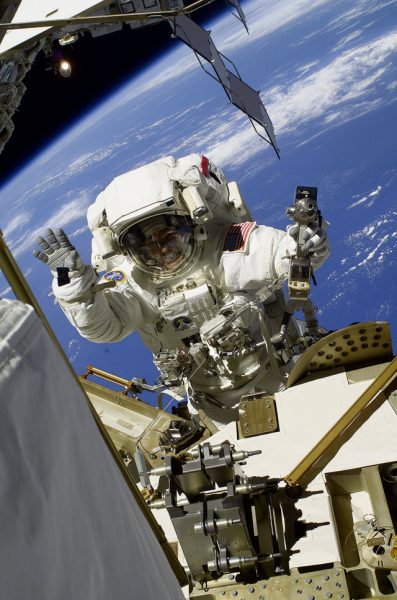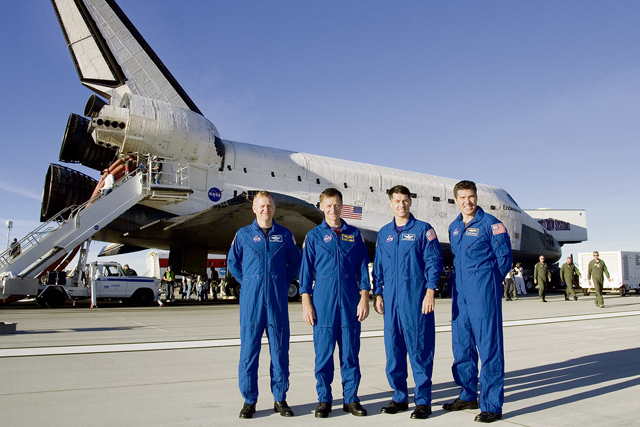
For NASA astronaut Stephen Bowen, it was the smell that immediately struck him as familiar.
“It has a unique odor,” he said of the first time he entered the International Space Station. “It has a little tinge of everything.”
It wasn’t the actual scents in the air, per se; the familiarity was more reminiscent of the many submarines he served on during his Navy career.
“I think you’ll find that when submariners retire, their spouses and family members will toss away all of their clothes because it has a very lingering odor,” Bowen said of submarine deployments. “But you get used to it very quickly.”
Bowen, a 1986 graduate of the Naval Academy, was chosen in 2000 to be the first submarine officer ever selected as a NASA astronaut. Between 2008 and 2011, he was part of three delivery missions to the ISS. It was on those missions that he learned the technology and environment of a space station were quite like that of a submarine.
“I could see the correlations,” Bowen said. “When I … first visited the space station on a shuttle flight, I knew the systems were the same. On my first mission, we brought up a whole lot of habitation and environmental control systems … and some of the technologies are exactly the same that we had on submarines.”
One example? The shuttle’s oxygen generator, which produces breathable air for the crew.
“When I first visited the company that made it, they pulled me aside and said, ‘Hey, do you want to see your Virginia-class [submarine] oxygen generator?’ And I said, ‘Yeah!’ And there it was. It was the exact same technology,” Bowen said.
Living and experimenting on the ISS
Last year, the seasoned astronaut took part in his biggest mission yet — commanding a SpaceX Crew Dragon spacecraft as part of NASA’s sixth commercial crew rotation mission to the ISS. Bowen and three others — American Warren “Woody” Hoburg, United Arab Emirates astronaut Sultan Alneyadi and Russian cosmonaut Andrey Fedyaev — launched March 2, 2023, and returned to Earth on Sept. 4 after 185 days of living aboard the space station.
Bowen said aside from the smell, the pace of the operation was also like that of a submarine deployment.
“You go to work every day… In this case, you’re doing a lot of science. You have your required exercise you do every single day, and every day … we have a different set of items on the schedule,” Bowen explained. “You do maintenance on top of that, and then every so often, there’s a peak of excitement where you’ve got an operation scheduled, like an EVA [extravehicular activity]. The week leading up to an EVA and then immediately following, you’re just really busy. You’re really focused on that event. It’s similar on submarines when we do some operations. So, when I landed [back on Earth], I was like, ‘Wow, that really felt like a submarine deployment.’”

When it comes to the science, there were hundreds of experiments and demonstrations on which Bowen and his fellow crew members worked. The team conducted a student robotics challenge, NASA said, and they released a satellite created by students at the University of Saskatchewan that tested a new radiation and protection system.
While several experiments took no work on their part, the team had to maintain, operate and participate in others. One, called Cardinal Heart 2.0, used an artificial beating heart to test whether certain drugs could reduce or prevent microgravity-induced changes to heart cell function and gene expression, which could damage an astronaut’s heart.
“It was really kind of cool,” Bowen said. “Sultan [Alneyadi] was looking through the microscope, and you could hear the voice of the primary investigator just getting really excited on the other end of the line because you can see a heart cell beating.”
He said there was also a biofabrication facility in which they were able to 3D print a replica of a knee’s meniscus.
“What’s way cool about that is because you’re in a microgravity environment, you can do things you can’t do on Earth. If you tried to do this on Earth, it would just collapse — the structure would collapse on itself,” Bowen said. “But in orbit, as we’re circling the Earth, that environment allows us to print each layer, and it stays that way. Then it becomes an actual piece of tissue, which is absolutely amazing.”
He said they also do a lot of combustion science and material science. Technically, he said the astronauts themselves were an experiment.
“We do a lot of biological sampling, and even in orbit, we do some processing for those samples. Ultimately, that all comes back down and helps us understand how the human body reacts in this environment,” Bowen said. “Sometimes I think it’s hard for people to grasp that what we’re doing in orbit, the purpose from it is for here on Earth. By eliminating the gravity component, we’re better understanding the processes of all these systems.”
Having completed 10 spacewalks over the past 15 years, Bowen is tied with four others for the record for most excursions by a U.S. astronaut. He ranks third on the all-time list for cumulative hours of spacewalking at nearly 66 hours.
And while Bowen said the views from the ISS handily beat out those offered by a submarine, when it comes to culinary creations, submarines still take first place.
“We always had great food on submarines,” he said. “They worked very hard to ensure that our food on board the space station is really high quality, but you’re just kind of limited by the technology. We don’t cook in space. We basically reheat and rehydrate, so it’s hard, but they do a really good job.”
From the Navy to NASA
Bowen said that as a kid, he dreamed of being an engineer, which led him to the Naval Academy and submarines. He said he applied for NASA on a whim, not thinking he would ever be selected.
“When I applied, we had about 8,000 applicants, and we had 17 selected,” he said.
When Bowen learned he made the cut, he said he actually considered turning it down.
“When they called me, I was a pre-commissioning unit executive officer for Virginia [class submarines], and it was so exciting to be a part of a crew establishing the initial operating capabilities of a submarine,” he explained. “For a moment, I almost thought, ‘I’ll say no,’ because we were looking forward to moving back up to Connecticut. But I’m very, very happy I said yes.”
While many astronauts have military backgrounds, not all do. Bowen said the team aspect of his military experience gave him a leg up during his space endeavors.
“When we select a [astronaut] class, that’s one of the things we look for in the non-military: have they participated in something where you have to be a part of a team?” he said. “That teamwork, that leadership and followership … is really important.”
Bowen said as space becomes more accessible, more opportunities will arise for those hoping to become an astronaut.
“There’s going to be other companies out there looking for people with skills for becoming an astronaut to fulfill their needs as we commercialize low-Earth orbit, and it’s really exciting to realize that we’re just right on that edge,” he said.
So, if your dream is to one day go to space, Bowen offered this recommendation: “If you’re interested, apply. The worst they can say is no.”


